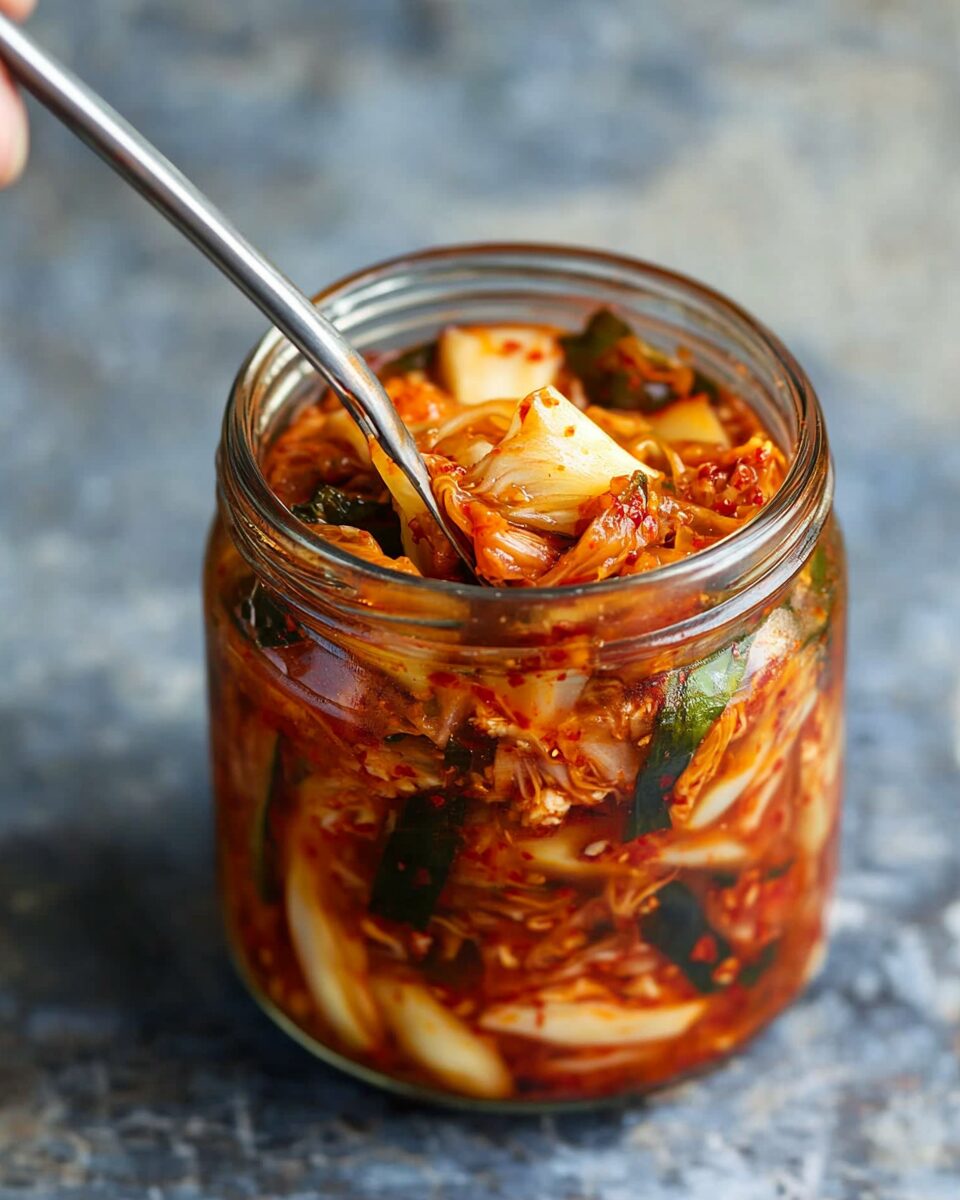Kimchi is a traditional Korean dish made from fermented vegetables, primarily napa cabbage. This beginner-friendly recipe allows you to create delicious kimchi at home, adding a probiotic-rich food to your diet.
FULL RECIPE:
Ingredients
- 1 medium napa cabbage (about 2 pounds)
- 1/4 cup sea salt
- 1 tablespoon rice flour (optional, for rice thickener)
- 1/2 cup water (for rice thickener)
- 4 green onions, cut into 1-inch pieces
- 1 tablespoon minced garlic
- 1 teaspoon grated fresh ginger
- 2 to 3 tablespoons gochugaru (Korean red chili flakes), adjust to taste
- 1 tablespoon fish sauce
- 1 teaspoon sugar
Directions
-
Prepare the Cabbage: Cut the napa cabbage lengthwise into quarters and remove the core. Chop into 1 to 2-inch pieces. Place the cabbage in a large bowl and sprinkle with sea salt, ensuring even coverage. Let it sit for 1 to 2 hours, tossing occasionally, until the cabbage softens and releases water.
-
Rinse and Drain: After salting, rinse the cabbage thoroughly under cold water to remove excess salt. Drain well and set aside.
-
Make the Rice Thickener (Optional): In a small saucepan, whisk together the rice flour and water. Cook over medium heat, stirring constantly, until it thickens into a paste. Let it cool to room temperature.
-
Prepare the Kimchi Paste: In a large bowl, combine the cooled rice thickener (if using), minced garlic, grated ginger, gochugaru, fish sauce, and sugar. Mix until a smooth paste forms.
-
Combine with Vegetables: Add the drained cabbage and green onions to the kimchi paste. Using gloved hands, thoroughly mix to ensure every piece is coated with the paste.
-
Pack and Ferment: Transfer the kimchi into a clean, airtight jar, pressing down to remove air pockets. Leave some space at the top for expansion. Seal the jar and let it ferment at room temperature for 1 to 2 days, depending on your taste preference and ambient temperature.
-
Refrigerate and Enjoy: Once fermented to your liking, refrigerate the kimchi. It can be consumed immediately but develops deeper flavors over time.
Nutrition Facts
- Calories: 23
-
Total Fat: 0.8g
- Saturated Fat: 0.1g
- Cholesterol: 0mg
- Sodium: 747mg
-
Total Carbohydrates: 3.6g
- Dietary Fiber: 2.4g
- Sugars: 1.6g
- Protein: 1.7g
- Vitamin A: 7.5µg
- Calcium: 50mg
- Iron: 3.8mg
The Fermentation Process and Its Benefits
One of the most fascinating aspects of kimchi is its fermentation process. When left at room temperature, the natural bacteria present on the cabbage and in the seasoning paste begin to break down the sugars, producing lactic acid. This process not only preserves the cabbage but also enhances its nutritional profile. Fermented foods like kimchi are rich in probiotics, which are beneficial bacteria that support digestion and overall gut health. These probiotics contribute to a balanced gut microbiome, which has been linked to improved immunity, better mental health, and reduced inflammation. Some people prefer fresh kimchi, which is less sour and has a crisp texture, while others enjoy the deep, tangy flavors that develop over weeks or even months of fermentation.
Health Benefits of Kimchi
Kimchi is widely recognized for its health benefits. It is low in calories but packed with essential vitamins and minerals such as vitamin A, vitamin C, and vitamin K. These vitamins play a crucial role in maintaining healthy skin, supporting the immune system, and promoting bone health. Additionally, kimchi is a great source of fiber, which aids digestion and promotes a feeling of fullness, making it an excellent addition to weight management diets. The probiotics in kimchi are particularly beneficial for gut health. They help maintain a balance of good bacteria in the digestive system, which can improve nutrient absorption and reduce symptoms of bloating, constipation, and irritable bowel syndrome. Studies suggest that regular consumption of fermented foods like kimchi may even contribute to mental well-being by promoting a healthy gut-brain connection.
Versatility in Cooking
Kimchi is not only enjoyed as a side dish but is also incorporated into various Korean and fusion recipes. One of the most popular dishes made with kimchi is kimchi jjigae, a spicy and savory stew that combines aged kimchi with tofu, pork, or seafood. The deep, umami-rich flavor of fermented kimchi adds a delicious complexity to the broth, making it a comforting and satisfying meal. Kimchi fried rice (kimchi bokkeumbap) is another beloved dish that transforms leftover rice and kimchi into a flavorful, spicy meal. It is often topped with a fried egg, adding a rich, creamy contrast to the tangy, spicy flavors of the kimchi. Kimchi can also be used in pancakes (kimchi jeon), stir-fries, dumplings, and even grilled cheese sandwiches for a fusion twist. For those who enjoy experimenting with flavors, kimchi can be added to non-Korean dishes as well.
Storing and Handling Kimchi
Proper storage is key to maintaining the quality of kimchi. Since it continues to ferment even after being made, storing it in an airtight container in the refrigerator helps slow down the fermentation process and prevents it from becoming overly sour too quickly. Using a dedicated kimchi container or glass jar is recommended, as the strong aroma can seep into plastic containers. Kimchi should always be stored in its brine to prevent it from drying out. The brine contains beneficial bacteria that contribute to the fermentation process and help preserve the cabbage. When handling kimchi, it is important to use clean utensils to prevent introducing unwanted bacteria that could spoil the batch. Properly stored kimchi can last for several months, and even when it becomes too sour to eat on its own, it can still be used in cooked dishes like stews and stir-fries.
Advertisement
Conclusion
Kimchi is more than just a side dish it is a cultural symbol, a health-boosting superfood, and a versatile ingredient that can enhance a wide range of dishes. Its rich history and deep-rooted significance in Korean cuisine make it a beloved food worldwide. The fermentation process not only develops its bold flavors but also provides numerous health benefits, from improving gut health to supporting the immune system. Making kimchi at home is a rewarding experience that allows for customization of spice levels and fermentation duration. Whether eaten fresh or aged, kimchi adds an exciting depth of flavor to meals and contributes to a well-rounded, nutritious diet.






